![]()
![]()
![]()
Use LEFT and RIGHT arrow keys to navigate between flashcards;
Use UP and DOWN arrow keys to flip the card;
H to show hint;
A reads text to speech;
25 Cards in this Set
- Front
- Back
|
Pathogen |
Viruses, bacteria or other living organisms that cause disease. |
|
|
Immune response |
A specific response to a pathogen. |
|
|
Define a self antigen |
Specific molecules such as proteins that act as markers to identify our cells as belonging to us. |
|
|
Antigen |
Antigens are macromolecules that elect a immune response in the body. |
|
|
Name 3 chemical barriers |
Sebum, antibacterial fatty acids, tears, gastric juice. |
|
|
What are the 3 non specific responses? |
Inflammatory response, phagocytosis, blood clotting. |
|
|
Why is the skin a good defence? |
Dry, contains keratin that can't be broken down easily. Outer layer sheds. Sebum inhibits growth of microorganisms. Sweat and tears contain lysozyme. |
|
|
How does the gut act as a defence? |
HCl acid in stomach destroys ingested bacteria. Mechanical flushing. |
|
|
How does the respiratory tract act as defence? |
Mucus (goblet cells) traps particles and pathogens. Cilia sweeps mucus towards the throat. |
|
|
How does the urinary/ reproductive tract act as a defence? |
Semen is antibacterial, the vagina has a mucus membrane coated in lactic acid. The urethra is acidic due to urine. |
|
|
Explain phagocytosis |
- phagocyte attracted to pathogen - phagocyte receptors attach to pathogen - lysosomes move towards engulfed pathogen - lysosomes release enzymes to hydrolyse the pathogen - antigens are displayed on the surface |
|
|
Explain cell mediated immunity |
-Receptors fit specific antigens on the phagocyte -T cells divide by mitosis (clonal expansion) - cytokines activate phagocytes, b cells, and cytotoxic t cells -cytotoxic t cells have perforin that makes holes in the infected cells. |
|
|
Explain the humoral immune system |
- b cells present antigens - T cells attach and activate the cell - b cells divide by mitosis to produce plasma cells. - specific antibody is produced - antibody binds and destroys - plasma cells develop into memory cells (secondary response) |
|
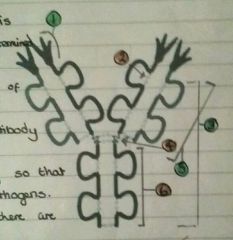
Label 1 of an Antibody |
1.variable region which is complementary determined by amino acid sequence |
|
|
Define passive immunity |
Antibodies enter from an outside source, immediate but are broken down and not replaced. Short lasting. |
|
|
Define active immunity? |
is produced by stimulating own immune response,this takes time but is long lasting. |
|
|
Define natural active immunity |
Results from being infected by the pathogen. |
|
|
Define Artificial active immunity |
vaccination immunity, introducing an immune response without suffering symptoms. |
|
|
Vaccinations contain... |
Antigens from the pathogen to cause an immune response. |
|
|
What does hiv stand for? |
Human immunodeficiency virus |
|
|
How does a virus such a hiv work? |
It infects T helper cells. Virus produces Dna copy of its RNA. DNA is inserted into the chromosomes. When it replicated, more viral dna is produced. |
|
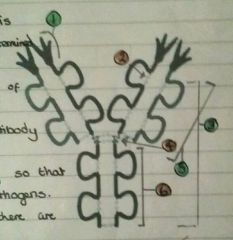
Label 2 of an Antibody |
2. Disulfide bridges keep shape of antibody in the tertiary structure |
|
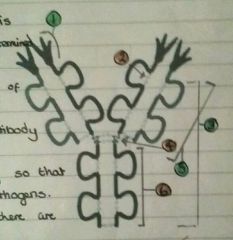
Label 3 of an Antibody |
3.constant region allows the antibody to bind to cell receptors |
|
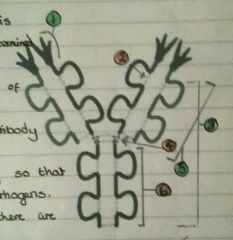
Label 4 of an Antibody |
4.hinge region flexibility to attach to two pathogens |
|
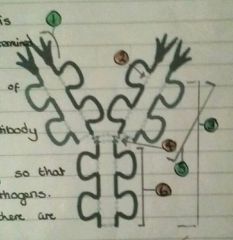
Label 5 and 6 of an Antibody |
5.light polypeptide chain6.heavy polypeptide chain |

